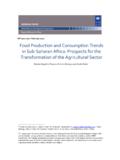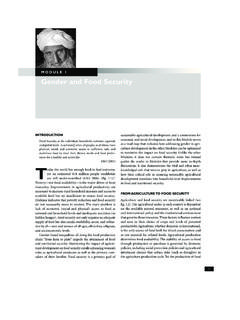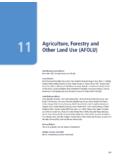Transcription of Livestock production systems in developing countries ...
1 Rev. sci. tech. Off. int. Epiz., 2006,25(2), 505-516 Livestock production systems in developingcountries: status, drivers, trendsH. Steinfeld, T. Wassenaar & S. JutziAnimal production and Health Division, Food and Agriculture Organization of the United Nations, Viale delleTerme di Caracalla, 00100-Rome, ItalySummaryThis paper describes and assesses the current status of Livestock productionsystems, the drivers of global Livestock production , and the major trends in suchproduction. The analysis covers the six major Livestock species: cattle andbuffaloes, goats and sheep, pigs and chickens. Global drivers of the livestocksector include economic growth and income, demographic and land usechanges, dietary adjustments and technological change.
2 The rate of change anddirection of Livestock development vary greatly among world regions, with Asiashowing the most rapid growth and structural change. The paper also examinessystem dynamics, by analysing the ways Livestock production has adjusted toexternal forces. A brief discussion of how these trends link to food safetyconcludes the Livestock production system Structural production is undertaken in a multitude of waysacross the planet, providing a large variety of goods andservices, and using different animal species and differentsets of resources, in a wide spectrum of agro-ecological andsocio-economic conditions.
3 Within this wide variety oflivestock production there are certain patterns that havebeen categorised into various Livestock production systems (LPS). Most frequently, these systems have been defined onthe basis of land use by Livestock , and for this purpose thedistinction between grazing systems , mixed farmingsystems and industrial (or landless) systems (12) has beenwidely order for decision-makers to address the Livestock -related food safety challenges in global markets, it may beuseful to look at LPS as the basic building blocks of thesector. Livestock production is undergoing rapid change,and this change manifests itself in the growingcontribution that Livestock makes to satisfying increasingglobal demands for high-value food products, and incontinuous adjustments at the level of resource-useintensity, size of operations, product orientation andmarketing channels.
4 This paper describes the current status of LPS, and thedrivers of and major trends in global Livestock to the limitations of space, this cannot be more than acursory analysis, highlighting the principal features anddevelopments. Six major Livestock species are covered(cattle and buffaloes, goats and sheep, pigs and chickens).First, the global drivers of the Livestock sector arediscussed, in particular economic growth and income,demographic and land-use changes, dietary adjustmentsand technological change. Second, the status of the mainLPS is described, with some attention to regionaldifferences. Third, system dynamics are examined, byanalysing the adjustment of Livestock production toexternal forces (this section is largely based on Costales etal.)
5 ,2006 [3]). A brief discussion of how these trends linkto food safety concludes the drivers of the Livestock sectorIndividual consumption of Livestock products is closelyrelated to per capita income. That is, with growing incomespeople typically increase their consumption of meat, milkand eggs until these products become fully integrated intothe daily diet. In high-income countries , per capitaconsumption of meat ranges between 80 kg and 130 kgper year; there is practically no further increase beyondthat level. As incomes in many developing countries havegrown rapidly over the past 20 years, consumption levelsof meat and other Livestock products have also economies of developing countries achieved anaverage annual growth of ( per capita) from1991 to 2001, up from during the ten precedingyears.
6 developing countries in East Asia, in particular, haveexperienced very strong economic growth, with an annualrate of ( per capita) over the decade between1991 and 2001, with the People s Republic of Chinaleading as the world s fastest growing economy. South Asiaand the Near East follow, with gross domestic productgrowth rates of and over the same expansion has been more modest in LatinAmerica, at annually, and in sub-Saharan Africa (Table I).In addition to higher incomes, increases in humanpopulations add to the demand for animal-source foodproducts. Most developing countries still have rapidlygrowing populations even though percentage growth ratesare below their peak in the 1970s.
7 Each year, the humanpopulation in developing countries grows by 72 million,adding to the demand for food products. There are widedifferences among developing countries ; populationgrowth has slowed down to in East Asia whereas itremains high in sub-Saharan Africa ( ) and in the NearEast/North Africa region ( ). In addition to populationgrowth, the population structure is also changing:urbanisation is fast increasing and it is projected that by2007 the majority of the human population will live incities (13). Urban people adopt new eating habits,consuming higher amounts of animal protein, and eating ahigher proportion of their food away from , many populations in developed anddeveloping countries are aging, with a decliningproportion of the total population younger than 15 also has an impact on total food demand and on thetype of food consumed.
8 Table II gives an overview of the important changes thathave occurred in the average diets of people in variousworld regions. People in industrialised countries derivemore than 40% of their dietary protein intake from food oflivestock origin (the figures do not include fish and otherseafood), and little change occurred between 1980 and2002. Changes have been most dramatic in Asia, wheretotal protein supply from Livestock for human dietsincreased by 131%, followed by Latin America, where percapita animal protein intake rose by nearly a third. Incontrast, there has been a decline in Livestock consumptionin sub-Saharan Africa, reflecting economic stagnation anda decline in available increasing share of Livestock products in the humandiet in many developing countries is part of a dietarytransition that has also included a higher intake of fats,fish, vegetables and fruit, at the expense of staple foodssuch as cereals and increasing demand for animal-source foodproducts exerts pressures on the Livestock sector , whichneeds to adapt fast in order to cope with such sci.
9 Tech. Off. int. Epiz., 25(2)506 Table IEconomic growth rates, per capita gross domestic product(GDP) growth rates and human population growth rates (annual rates during the period 1991 to 2001)RegionGDP growth Per capita GDPP opulation rates (%)growth rate (%) growth rate (%)East Asia and East and North America and and : World Bank (14)CIS: Commonwealth of Independent StatesEE: Eastern EuropeOECD: Organization for Economic Co-operation and DevelopmentTable IIDaily protein supply from Livestock and from all sources in 1980and 2002 (in grams per capita)RegionTotal protein from livestockTotal protein1980200219802002 Sub-Saharan : FAOSTAT (7.)
10 Accessed June 2006)These adjustments are based on a changing feed resourcebase, particularly feed concentrates. Current and projectedlevels of Livestock production would not be possiblewithout the expanding production and yield increase ofcrop agriculture. Traditionally, Livestock production usedto be based on locally available feed resources, includinglocal fodder, crop residues and unconsumed parts ofhuman food resources that had no value as human , natural pastures were the venue of livestockproduction. More recently, however, a growing proportionof pastureland in developing countries is in areas which areunfit or marginal for cropping, and degraded arable land isoften converted into pastureland.















